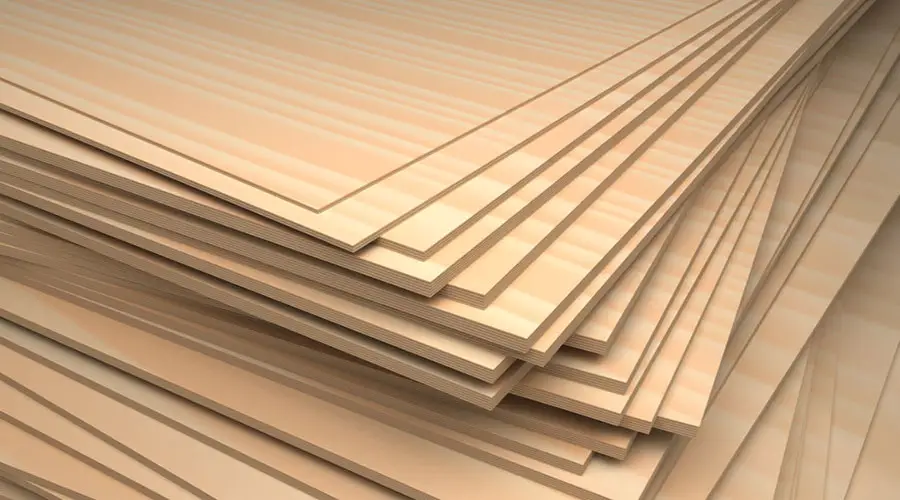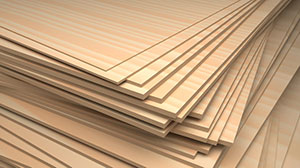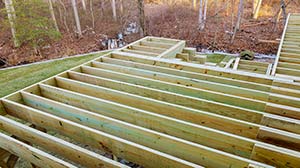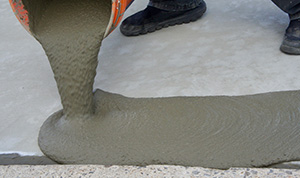
Luan plywood is a plywood product generally harvested from tropical trees in the Shorea family.
It is sturdy and has excellent bend resistance. Yet, not all luan is equal. Luan is a general term for a family of luan mahogany plywoods. Builders have to distinguish the best grade per project.
Luan plywood, surprisingly, has countless uses. It is often used for furniture and cabinetry but is popular for many other uses in construction because it is lightweight and easy to work with. From flooring to countertop replacements, luan can be useful for many building projects.
The Wood Database writes that there are many varieties of luan because of the different tree species used to make it. Each of these varieties has its work and strength values. It also looks different, which helps when you need to distinguish visually between the kinds.
The general meranti luan has four shades: light red, dark red, white, and yellow. Balau is a fifth luan variety.
Even though luan is sometimes called Philippine mahogany, it has no relation to standard mahogany. This type of mahogany comes from Swietenia and Khaya trees. Luan comes from a tropical tree called the Shorea genus is found in the rainforest.
10 Uses of Luan Plywood
As the debate keeps the conversation about luan going, builders and DIYers reveal the projects where they used luan. Ten projects topped popular lists. At the same time, they sparked more debate.
1. Underlayment for Vinyl Flooring
Builders argue over luan underlayment, possibly the most common suggested use for luan. Some say to use it as a substrate piece when putting down vinyl flooring because of its smooth surface.
Homebuilders’ guidelines give mixed opinions about using it for this purpose. Homebuilders also argue that there are better material alternatives, with some even saying to avoid luan entirely. It can be confusing for the first-time home builder. How do you know when to use luan plywood as underlayment and when not?
The key is to be aware of different luan grades. If you will use this wood, you should check for the water-resistant variety. Interior luan wood gets disqualified for outdoor flooring underlayment, such as flooring projects in home-adjacent mudrooms. Non-water resistant luan will have a high warp rate when exposed to water.
You can stop luan warping with a few simple tricks. Ring shank nails can prevent warp. To add a new vinyl roll to old vinyl, use luan as a subfloor layer. Apply luan subfloors with ring shank nails.
Note that builders say this will depend on your project.
Vinyl Floor Underlayment Prep
Prep your vinyl floor for luan wood underlayment. Scrub the floor to remove debris. This technique comes from the best luan blog. Our friendly builder says to apply a fine layer of cement after this.
Lay the luan sheets on the foam pad underlayment. You can staple it in place.
2. For Small Woodworking Projects
Most people who use luan for woodworking crafts do so because it is easy to cut. Luan is cheap, making it the go-to craft wood for the habitual DIYer.
Luan is the perfect plywood for dollhouses and toys. This plywood is also an ideal cabinet-making material.
Kerfing
Builders recommend using luan for kerfing techniques. The kerfing method uses a table saw to make parallel cuts and the plywood to allow it to bend in a curve. You can use this curve to wrap the luan wood around an area of a small woodworking project. Bend the wood with kerfing and fasten it in place for projects that require wood wrapping structural support.
Steaming
Luan works well with steaming techniques. You use a steam box to heat and moisturize the wood. Once the wood is pliable, place it on a mold and clamp it. After this, you will allow it to cool and dry.
The hot water wood molding technique builds wood instruments and mannequins. Steaming is harder than kerfing, requiring a specialized process.
Safety note: Pliability comes with a small price. Luan wood is thin, which adds some difficulty to trimming it. Use safety guidelines when cutting this wood with die-cut tools. Be aware that there are times when the wood splinters when you use an intricate tool to shape it. Supervise children while doing luan woodwork crafts with hand tools.
3. For Parts on Small Boats
Luan is famously resilient. Woodworkers love to use this wood for small boats such as kayaks or canoes. Boat-builders also use it for decking.
Luan also famously warps with water pressures. If you apply the tricks for warp prevention, you should be out of the woods for the most part. Still, you may want to seek an alternative for your boat depending on your project.
Check Your Grade
There are varying grades of luan to consider for these types of projects. Look for luan wood that is of an outdoor or water-resistant luan.
Grabbing non-water-resistant grade luan for your boat project guarantees the boat a short lifespan.
4. As Finishing Wood in Humid Areas
Features that make this wood a choice for boats also see it selected for the humidity-exposed house project. Use luan wood as a finishing wood for parts of your home where humidity hits the hardest.
You will, of course, use the same rules for boat-building here. Look for a water-resistant luan as this will live longer under humid conditions. Exterior-grade luan is the best choice for this purpose. Remember that not all grades of exterior luan are equal. Best practices ensure that you do pre-buying homework with your project area.
5. Interior Door Layering
We see lots of homebuilders recommending luan for interior door support. Builders have described luan wood as better for indoor use because those grades do not respond well to prolonged water exposure.
6. Furniture Backing
You always have that one favorite recliner that you never want to retire. Knowing luan is good furniture backing is good news. Luan wood can provide a flexible bit of furniture backing, reinforcement, or replacement for old furniture.
7. Drawer Bottoms
A strip of luan in the bottom of a dresser drawer adds some extra flexibility. You use luan here because you may use it as a substrate for vinyl floors. This wood can bend without breaking, empowering it to hold all of the junk or hoards of clothes in your dressers.
8. Flexible Skateboard Ramps
One Houzz.com member used Luan to make a skateboard ramp. Luan works well for ramps because it has a high bend resilience and a smooth surface. Skateboard tricks create friction, and luan is a flexible board that can hold up to it. With the exterior grade and a coat of oil-based paint, a skater can make the most of using this cheap plywood for a ramp project.
9. Countertop Replacement Projects
Because it is affordable, Luan is a go-to wood for house projects and replacement needs. Countertops that need wooden reinforcement choose this wood because it is cheap. Countertop designs are sometimes tiled over with vinyl. For this style, the luan plywood works as a substrate for vinyl flooring projects.
However, countertops see frequent fluid exposure. Aside from selecting a higher grade luan, you would also want to concentrate on getting veneer protection.
10. Millwork Applications
Builders and DIYers swear that Luan is great feature material for your millwork. Millwork applications shape architecture, historically and into the present. These shape the character of the house or structure.
Millwork applications fashion in mills. Wood goes through a series of techniques for moldings.
Millwork comes in a variety of stock and custom designs. Millwork applications are from door trim to door jambs, window casing, and other similar pieces.
Luan is a flexible wood used in these applications. Luan wood has easy usability for woodworking techniques such as kerfing and steaming, making it a ready wood for millwork.
Luan has universal uses wherever there is a need for bendable thin wood. You should be aware of some downsides to using luan before picking it for your next project. Some of these issues center around earth-friendliness.
Is Luan Plywood Good?
Luan plywood is good for a project that recommends wood with bend capacity. Stiff boards will snap where luan will bend. Knowing the purpose of your project and where you plan to put on the wood will determine whether luan is the best material to use.
But luan wood has one downside. Risks to rainforests go up to produce it. Major hardware retailer Home Depot was among hardware suppliers that got sued over rainforest conservation failure. The conservationist approach to using tropical trees is to replant as much forest as used for material.
But, seeking alternative wood sources may not be the straightforward answer to preserving rainforests. Alternative plywoods similar to luan are taken from temperate zone trees. An increase in wood sourcing from the temperate zone, without proper conservation, will lead to the same problems rainforest forestry faces when cutting down trees for luan plywood.
If you are concerned about forest-friendly wood use, you can seek plywood made from recycled materials. Buy wood made of recycled newspaper, woodchips, or sawdust for a better alternative.
These materials exclude the use of a new tree. A balance between trees cut and trees planted is essential to preserving forests.
Although, forest-friendly does not mean completely earth-friendly. Unfortunately, some wood by-products put off chemicals that create environmental concerns. Do your research when choosing aftermarket alternatives to grasp the chemical footprint’s full range.
What Can I Use Instead of Luan?
You have now entered a whole new argument. Luan wood gets shown up by alternative products in current builder trends. These products range from environmentally friendly to woods more suited for specific projects with a similar price point.
Alternatives include the following:
- Chinese birch plywood
- Plywoods with NAF or ULEF or CARB Phase 2 mill stamps
- Sustainable FSC-certified plywood
- Acrylic panel (cheap and waterproof)
- Recycled newspaper plywood, an alternative to rainforest woods
- Hardboard, which comes from recycled sawdust (may not be as flexible)
- High-density fiberboard (contains formaldehyde)
- Temperate hardwood plywood (a luan look-alike, made from beech, birch, or maple)
These alternatives generate debate, as builders disagree over the alternative environmental efficiency. Formaldehyde-containing plywoods can present hazards to the environment. Other plywoods on this list manufacture with harsh chemicals that are not basic needs safe.
You will run into issues such as higher costs, sacrificed flexibility, etc. Alternatives to luan wood will come down to the scale of your project.
Inferior Plywoods
Luan has its issues, but there are other woods that builders see as inferior in terms of the scope of applications. This inferiority depends on the project and not the standalone quality of the wood.
Pair woods to the woodworking project. Planning a project helps cut costs by avoiding buying less usable products.
For example, Apitong is similar to Luan, yet timber experts say it is not as good as finishing wood because of its coarseness.
People make complaints, but luan has unique qualities a builder should consider. Luan could make all the difference for the builder, the experience, and the longevity of the craft in question.
Frequently Asked Questions?
How Thick is Luan Plywood?
Luan plywood is available in different thicknesses, but the most common thickness is ¼ inch. This type of luan plywood is often used as an underlayment for flooring projects. You can also use it to make cabinets, shelves, and other storage solutions.
You can also find luan in thicknesses of ½ inch and ¾ inch. These thicker plywoods are often used for building cabinets and crafts and DIY projects.
How to Cut Luan Plywood?
You can cut luan plywood with a skill saw or utility knife. If you are using a skill saw, it is important to use a blade designed to cut plywood. This will help to prevent the wood from chipping or splintering. It is also important to wear gloves and a dust mask when cutting luan plywood to avoid inhaling the dust.
If you use a utility knife to cut luan plywood, it is important to use a sharp blade. A dull blade will cause it to tear and chip. You will essentially score the luan along a straight or chalk line to break the edge. This method only works with thin luan.
What Glue for Vinyl Floor to Luan Plywood?
There are a few different types of glue that can be used to attach vinyl flooring to luan plywood. The type of glue you use will depend on the project you are working on and the materials you are using.
Contact cement is one type of glue that you can use to attach vinyl flooring to luan plywood. Contact cement is applied to the luan plywood with a brush or roller. The two materials are pressed together to create a tight bond and remove air bubbles with a rubber roller.
Another type of glue that you can use to attach vinyl flooring to luan plywood is construction adhesive. This type of glue is applied evenly to the luan plywood and then lay the vinyl flooring and use a roller to remove air bubbles.
How Heavy is Luan Plywood?
Luan plywood is a lightweight material that is often used for flooring, cabinets, shelves, and DIY hobby projects. The weight can vary depending on the thickness. The most common thicknesses of luan plywood are ¼ inch, ½ inch, and ¾ inch.
The weight can also vary depending on the type of wood used. Luan plywood is typically made from fir or mahogany. Fir is a lightweight wood often used to make cabinets and shelves. Mahogany is a heavier wood that is often used for flooring.
What’s the Best Paint for Luan Plywood?
The best paint for luan plywood is water-based acrylic paint, which adheres well to luan plywood and will provide a durable finish. It is also important to select a paint that is designed explicitly to ensure that the paint adheres properly.
What Does 3-Ply Mean for Luan Plywood?
The term “ply” refers to the number of layers used to make luan plywood. The most common types are three-ply and five-ply. Three-ply luan plywood is made from three layers of wood, while five-ply luan plywood is made from five layers of wood.
The number of layers in luan plywood can affect the strength and durability of the plywood. Five-ply luan plywood is typically thicker, stronger, and more durable than three-ply luan plywood.
Takeaways
You can use luan in multiple areas of the house. It can be bent to serve a useful purpose, such as making aesthetically beautiful kitchen countertops.
Luan is cheap and flexible, making it convenient for craft projects. However, if your purpose is a large scale, consider alternatives. Be mindful of the environmental issues that may arise when using luan.
Overall, luan is still one of the best options for plywood.







